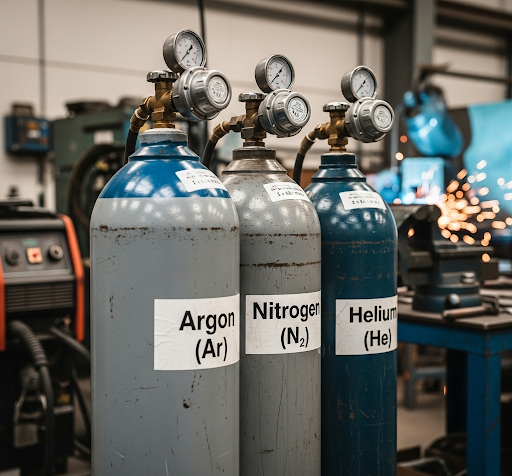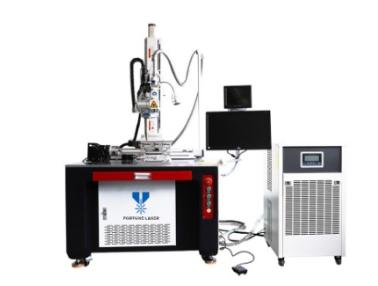Choosing the right laser welding assist gas is one of the most critical decisions you’ll make, yet it’s often misunderstood. Ever wondered why a seemingly perfect laser weld failed under stress? The answer might be in the air… or rather, in the specific gas you used to shield the weld.
This gas, also called shielding gas for laser welding, isn’t just an optional add-on; it’s a fundamental part of the process. It performs three non-negotiable jobs that directly determine the quality, strength, and appearance of your final product.
It Protects the Weld: The assist gas creates a protective bubble around the molten metal, shielding it from atmospheric gases like oxygen and nitrogen. Without this shield, you get catastrophic defects like oxidation (a weak, discolored weld) and porosity (tiny bubbles that compromise strength).
It Ensures Full Laser Power: As the laser hits the metal, it can create a “plasma cloud.” This cloud can actually block and scatter the laser’s energy, leading to shallow, weak welds. The right gas blows this plasma away, ensuring the full power of your laser reaches the workpiece.
It Protects Your Equipment: The gas stream also prevents metal vapor and spatter from flying up and contaminating the expensive focusing lens in your laser head, saving you from costly downtime and repairs.
Choosing a Shielding Gas for Laser Welding: The Main Contenders
Your choice of gas boils down to three main players: Argon, Nitrogen, and Helium. Think of them as different specialists you’d hire for a job. Each has unique strengths, weaknesses, and ideal use cases.
Argon (Ar): The Reliable All-Rounder
Argon is the workhorse of the welding world. It’s an inert gas, meaning it won’t react with the molten weld pool. It’s also heavier than air, so it provides excellent, stable shielding coverage without needing excessively high flow rates.
Best For: A huge range of materials, including aluminum, stainless steel, and especially reactive metals like titanium. Argon laser welding is the go-to for fiber lasers because it delivers a clean, bright, and smooth weld finish.
Key Consideration: It has a low ionization potential. With very high-power CO₂ lasers, it can contribute to plasma formation, but for most modern fiber laser applications, it’s the perfect choice.
Nitrogen (N₂): The Cost-Effective Performer
Nitrogen is the budget-friendly option, but don’t let the lower price fool you. In the right application, it’s not just a shield; it’s an active participant that can actually improve the weld.
Best For: Certain grades of stainless steel. Using nitrogen for laser welding stainless steel can act as an alloying agent, stabilizing the metal’s internal structure to improve mechanical strength and corrosion resistance.
Key Consideration: Nitrogen is a reactive gas. Using it on the wrong material, like titanium or some carbon steels, is a recipe for disaster. It will react with the metal and cause severe embrittlement, leading to a weld that can crack and fail.
Helium (He): The High-Performance Specialist
Helium is the expensive superstar. It has very high thermal conductivity and an incredibly high ionization potential, making it the undisputed champion of plasma suppression.
Best For: Deep penetration welding in thick or highly conductive materials like aluminum and copper. It’s also the top choice for high-power CO₂ lasers, which are very susceptible to plasma formation.
Key Consideration: Cost. Helium is expensive, and because it’s so light, you need high flow rates to get adequate shielding, further increasing the operational cost.
Quick-Reference Gas Comparison
|
Gas |
Primary Function |
Effect on Weld |
Common Use |
|
Argon (Ar) |
Shields weld from air |
Very inert for a pure weld. Stable process, good appearance. |
Titanium, Aluminum, Stainless Steel |
|
Nitrogen (N₂) |
Prevents oxidation |
Cost-effective, clean finish. Can make some metals brittle. |
Stainless Steel, Aluminum |
|
Helium (He) |
Deep penetration & plasma suppression |
Allows for deeper, wider welds at high speed. Expensive. |
Thick materials, Copper, High-power welding |
|
Gas Mixtures |
Balances cost & performance |
Combines benefits (e.g., Ar’s stability + He’s penetration). |
Specific alloys, optimizing weld profiles |
Practical Laser Welding Gas Selection: Matching Gas to Metal
Theory is great, but how do you apply it? Here’s a straightforward guide for the most common materials.
Welding Stainless Steel
You have two excellent choices here. For austenitic and duplex stainless steels, Nitrogen or a Nitrogen-Argon blend is often the top pick. It enhances the microstructure and boosts the weld’s strength. If your priority is a perfectly clean, bright finish with no chemical interaction, pure Argon is the way to go.
Welding Aluminum
Aluminum is tricky because it dissipates heat so quickly. For most applications, pure Argon is the standard choice due to its fantastic shielding. However, if you’re welding thicker sections (above 3-4 mm), an Argon-Helium mixture is a game-changer. The helium provides the extra thermal punch needed to achieve deep, consistent penetration.
Welding Titanium
There is only one rule for welding titanium: use high-purity Argon. Never, ever use Nitrogen or any gas mixture containing reactive gases. Nitrogen will react with titanium, creating titanium nitrides that make the weld incredibly brittle and destined to fail. Comprehensive shielding with trailing and backing gas is also mandatory to protect the cooling metal from any contact with the air.
Expert Tip: People often try to save money by lowering their gas flow rate, but this is a classic mistake. The cost of a single failed weld due to oxidation far outweighs the cost of using the correct amount of shielding gas. Always start with the recommended flow rate for your application and adjust from there.
Troubleshooting Common Laser Welding Defects
If you’re seeing problems in your welds, your assist gas is one of the first things you should investigate.
Oxidation & Discoloration: This is the most obvious sign of poor shielding. Your gas isn’t protecting the weld from oxygen. The fix is usually to increase your gas flow rate or check your nozzle and gas delivery system for leaks or blockages.
Porosity (Gas Bubbles): This defect weakens the weld from the inside. It can be caused by a flow rate that’s too low (not enough protection) or one that’s too high, which can create turbulence and pull air into the weld pool.
Inconsistent Penetration: If your weld depth is all over the place, you might be dealing with plasma blocking the laser. This is common with CO2 lasers. The solution is to switch to a gas with better plasma suppression, like Helium or a Helium-Argon mix.
Advanced Topics: Gas Mixtures & Laser Types
The Power of Strategic Mixtures
Sometimes, a single gas doesn’t quite cut it. Gas mixtures are used to get the “best of both worlds.”
Argon-Helium (Ar/He): Blends the excellent shielding of Argon with the high heat and plasma suppression of Helium. Perfect for deep welds in aluminum.
Argon-Hydrogen (Ar/H₂): A small amount of hydrogen (1-5%) can act as a “reducing agent” on stainless steel, scavenging stray oxygen to produce an even brighter, cleaner weld bead.
CO₂ vs. Fiber: Choosing the Right Laser
CO₂ Lasers: They are highly susceptible to plasma formation. This is why expensive Helium is so common in high-power CO2 applications.
Fiber Lasers: They are much less prone to plasma issues. This fantastic benefit allows you to use more cost-effective gases like Argon and Nitrogen for the vast majority of jobs without sacrificing performance.
The Bottom Line
Choosing a laser welding assist gas is a critical process parameter, not an afterthought. By understanding the core functions of shielding, protecting your optics, and controlling plasma, you can make an informed choice. Always match the gas to the material and the specific demands of your application.
Ready to optimize your laser welding process and eliminate gas-related defects? Review your current gas selection against these guidelines and see if a simple change could lead to a major improvement in quality and efficiency.
Post time: Aug-19-2025











